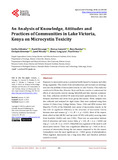| dc.contributor.author | Githukia, Cecilia | |
| dc.contributor.author | Onyango, David | |
| dc.contributor.author | Lusweti, Dorcas | |
| dc.contributor.author | Ramkat, Rose | |
| dc.contributor.author | Kowenje, Chrispin | |
| dc.contributor.author | Miruka, Jared | |
| dc.contributor.author | Lung’ayia, Henry | |
| dc.contributor.author | Orina, Paul | |
| dc.date.accessioned | 2022-04-27T06:34:18Z | |
| dc.date.available | 2022-04-27T06:34:18Z | |
| dc.date.issued | 2022-03-03 | |
| dc.identifier.uri | https://doi.org/110.4236/oje.2022.123012 | |
| dc.identifier.uri | https://www.scirp.org/journal/paperinformation.aspx?paperid=115853 | |
| dc.identifier.uri | http://ir-library.mmust.ac.ke:8080/xmlui/handle/123456789/2043 | |
| dc.description.abstract | Exposure to microcystin poses a potential health hazard to humans and other living organisms. This results from eutrophication and warrants an investigation into the problem of microcystin toxicity in Lake Victoria. This study was conducted in Homa Bay, Kisumu, Siaya and Busia counties to understand the effects of microcystin toxicity among fisherfolk and lake riparian communities. Data collection involved 90 semi-structured questionnaires, 11 key informant interviews and seven focus group discussions. Water samples were also collected and analysed for algal toxins. Data were analysed using Stata version 13 (Stata Corp, College Station, Texas, USA) and SPSS version 18.0. Majority (73.3%) of the fisherfolk were aware of microcystin toxicity in the lake with no significant difference in the awareness of microcystin toxicity between men and women (χ2 = 1.1, df = 1, p = 0.293). Most of the respondents relied on lake (48.9%) and tap water (47.8%) with paltry sourcing water from borehole (16.8%) and rain (7.8%). There was no association between level of education and water source (lake; χ2 = 1.61, df = 3, p = 0.656) and (tap; χ2 = 2.23, df = 3, p = 0.527). Fisherfolk was cognizant of the need to curb microcystin toxicity. There was a significant difference (p < 0.05) in the occurrence of microcystin during the wet season compared to the dry season. Cyanophytes were the most significant (p < 0.001) group of phytoplankton. When ingested, microcystin has a long-term effect and therefore pollution control is crucial. | en_US |
| dc.language.iso | en | en_US |
| dc.publisher | Open Journal of Ecology | en_US |
| dc.subject | Analysis, Knowledge, Attitudes, Practices, Communities, Lake, Victoria, Kenya, Microcystin, Toxicity | en_US |
| dc.title | An Analysis of Knowledge, Attitudes and Practices of Communities in Lake Victoria, Kenya on Microcystin Toxicity | en_US |
| dc.type | Article | en_US |

